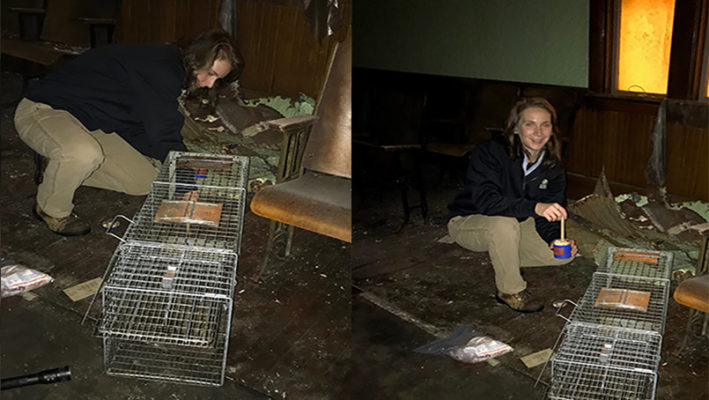
19 Dec 2018 Furry, Four-legged Squatters Evicted from Roxbury Church
HBI recently set about protecting Roxbury’s St. James African Orthodox Church from incurring any further damage due to weather and deterioration while we plan its rehabilitation. Squirrels were entering the church at the roof line, and it was obvious that larger animals had also gained access to the building. In addition to the waste they left behind, animals can be destructive by gnawing on elements of the structure and building materials. It became imperative that the building be sealed up for the winter without trapping animals inside. HBI contacted Environmental Health Services (EHS Pest) to humanely evict any animal occupants and secure any potential future access points. We asked Lis Kernan and John Stellberger of EHS Pest to share some information about how they get the job done.
HBI approached EHS Pest (Environmental Health Services, Inc.) to help with the early stages of the stabilization process of the 50 Cedar Street church. This beautiful old building has been vacant since 2015 and has a known history of resident raccoons. At EHS, we often deal with native wildlife that has become a “nuisance” because animals have chosen to move into people’s homes in order to share a roof, eat some snacks, get comfy, and feel both healthy and safe. Urban wildlife is extraordinarily resourceful, and a building left mostly unattended and unmaintained for a number of years has a lot to offer local critters seeking shelter from the New England seasons.

Lis sets the bait for the trap. The concoction is a combination of marshmallows and fish paste.
In pest management, the first step is to determine what species of animal or animals are present. This may sound simple, but pest species are often very good at remaining hidden or undetected. With keen observation and knowledge of specific animal behavior, it is possible to identify the species present without ever laying eyes on it. All wildlife species leave solid clues of their presence behind, and some of the most important things we first look for are: 1) distinctive entry holes, 2) evidence of movement patterns, 3) rub marks left behind from an animal’s oil glands (yes – we can see these!), and 4) characteristic droppings.
For example, most species of squirrels will widen existing small gaps to enter a structure, but a grey squirrel will often chew a full or mostly full circle, whereas a flying squirrel will chew one side of the hole to create a half-moon shape. Raccoons often leave muddy prints or scratches behind when they climb the sides of buildings, and bat droppings (“guano”) will fall apart into many pieces when crushed (because they’re composed of insect exoskeletons).

Some evidence is best collected from the reports of people living in a home with suspected wildlife – the times of day when noises are heard indicate whether a species is nocturnal or diurnal, and areas of a building where the noises are coming from indicate the known favorite hide-outs of certain species (e.g. bats tend to prefer attics to the rest of the house).
Our observational findings at each location dictate which methods we use to remove wildlife, all of which are guided by EHS’s basic philosophy of “live and let live.” The underlying strategy is one of humane removal and “exclusion” – we carefully remove the wildlife from inside a structure and then proof the exterior to prevent the wildlife from returning. To begin this process, we often employ one-way devices that allow wildlife to exit a hole they’ve been using but does not allow them to get back in again – for squirrels this looks like a door that only opens outwards, and for bats it’s a cone-shaped devices that they are able to fly out of but cannot crawl back into. Once we are sure that all animals are no longer within a structure, we can remove the one-way device and screen or seal over the original entry hole so nothing can return in the future.

In some cases, such as with the 50 Cedar St church where fresh raccoon droppings told us raccoons were likely still present, we employ live trapping that allows us to release an animal unharmed on the property once their entry holes have been sealed to prevent them getting back in. Raccoons are extremely clever and highly dexterous, so one-way doors are not an effective removal strategy for them. At the church, one of the techniques we used was raccoon eviction fluid applied around the entry hole to discourage released individuals from attempting to return – this is a by-product of male raccoon urine and is most effective for removing female raccoons from nesting sites during birthing season because it triggers a flight response. Because this type of passive “exclusion” method does not exist for other New England species, we often have to wait until the end of various fledging seasons to perform removal of bats, squirrels, skunks, or birds to avoid separating mothers from their young.
A vacant building can be an extraordinary oasis for wildlife, and the 50 Cedar St. church was no exception. After approximately 8 hours of wildlife exclusion on the property (which included the removal of raccoon droppings and sanitation of the church’s sanctuary) and an additional two weeks of live trapping, two raccoons and one surprise opossum were eventually removed from the church and released just outside the doors. Because these animals have lived their whole lives in this area and may have even been born inside the church, they are likely to remain close by as the restoration continues. The former access points will need to be checked periodically to make sure no one has come back in.



